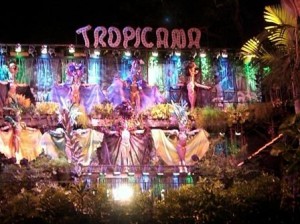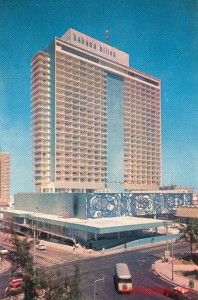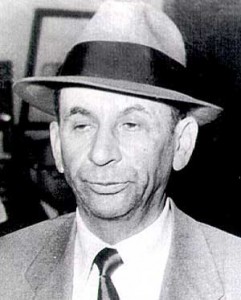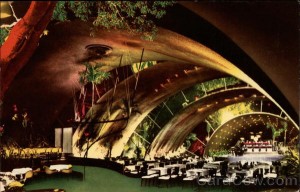[Reference: Dade County OCB file # 1-139]
DOCUMENT 0126
[NOTE: This entire document was not transcribed, only the references to Cuba and a little background for continuity.]
U.S. Treasury Department
Bureau of Narcotics
September 1961
Washington, D.C.
NAME: Santo TRAFFICANTE Jr.
ALIASES: ; Louis SANTOS; Enrique CHACON; Samuel BALTO
DESCRIPTION: Born 11-15-14, Tampa, Florida; 5′ 10″; 180lbs; brown eyes; brown-greying hair; wears glasses.
LOCALITIES FREQUENTED: Resides at 2505 Bristol Ave., Tampa, Florida; said to maintain a residence at 3010 N. Boulevard Ave., Tampa, Florida. During the Batista regime he resided at Calle 12, No. 20 Vedado, Havana, Cuba; has frequented Miami, St. Petersburg and Clearwater, Florida; New York.
in Cuba Report. (1954-1961)
In a letter dated March 27, 1958 Wm. W. Johnston, U.S. Treasury Representative in charge, Havana, Cuba reported the following:
1. Shortly after the Apalachin meeting, the Cuban Bureau of Investigation fingerprinted and photographed the American gamblers and their casino technicians. These photographs and fingerprints were then forwarded to Internal Revenue Agent James B. DeLuca for the information of the International Operations Division of the Internal Revenue Service.
2. Under Cuban law during the Batista regime, a gambling casino was not permitted to operate in a hotel establishment unless the hotel was valued at least one million dollars. An operating license cost from $25,000 to $50,000.
3. Once in operation, the Cuban Treasury Department collected 20 percent of the proceeds reported. However, due to pay-offs to various officials, the actual amount which ended up in the Treasury coffers was considerably less. About 70 percent of the customers were American tourists, the balance being wealthy Cubans and Latin Americans.
4. It was estimated that about 90 percent of the in the casinos were run legitimately. The reason for this was that the gamblers considered the setup in Cuba as strictly temporary, knowing full well that eventually they would have to return to the U.S.A.
5. For several years prior to 1955 the only casinos operating in Havana, Cuba were the TROPICANA and the Sans Souci. Both clubs served drinks and meals which just about covered the operating costs. The profits from gambling amounted to approximately $5,000 a day, after “deductions”. The newer casinos averaged even higher profits while the profits of the two original casinos remained more or less the same.
6. As of 1958 the following were the principal casinos in Havana, Cuba:
a. The TROPICANA – operated by Wilber Clark and Frank BISCHOPE. Frank BISCHOFF has been a suspected narcotic trafficker. His principal assistant in the casino was one Pierre CANAVESE who was closely associated with Salvatore LUCANIA alias Lucky Luciano, FBN International List No. 198. (CANAVESE had been previously deported from the U.S.A. to Italy but he subsequently entered Cuba by means of a fraudulent passport).
b. The SANS SOUCI – operated by Santo TRAFFICANTE Jr. One of Santo TRAFFICANTE Jr.’s principal assistants in the operation of this club was one Sid JACOBS alias Syd Mathews.
c. The RIVIERA CASINO – operated by Meyer LANSKIN FBN International List No. 169, Frank ERICKSON, Giordano CELLINI, Ed LEVINSON and one “Disty” PETERS. The RIVIERA CASINO was one of the more honest gambling casinos in Havana. Meyer LANSKY and Frank ERICKSON were suspected of being the real owners of the club. Frank ERICKSON represented racketeer Frank COSTELLO’S interests.
d. CASINO INTERNATIONAL – Hotel Nacional, operated by Wilbur CLARK. His principal assistants in the operation of this club were Edward GOFFREDO CELLINY and Merle JACOBS. As far as could be ascertained, CLARK, CELLINI, and JACOBS do not have any criminal records.
e. The SEVILLA BILTMORE, operated by Amletto BATTISTI, a Cuban citizen of Italian extraction. BATTISTI was kingpin of the “bolita” racket (lottery). He was the owner of the Sevilla Biltmore Hotel which he had leased to a Chicago concern. BATTISTI also owned and operated a bank in the hotel.
f. CAPRI HOTEL CASINO – operated by Nicholas Di COSTANZO and Charles TURIN believed to be identical with racketeer Charles TOURAINE [Tourine] alias Charley Blade. It was believed that George RAFZ, the movie star, owned a considerable interest in this club.
g. NATIONAL CASINO – operated by Jack LANSKY brother of notorious racketeer Meyer LANSKY, FBN International List No. 169. Jack and Meyer LANSKY owned the major portion of this casino and had in their employ a number of technicians from Las Vegas, Nevada. It was said that this casino was run strictly “on the level” because the habitues were the “boys” who demanded a square game when they felt like gambling.
h. HAVANA HILTON CASINO – Operated by Clifford JONES of Las Vegas, Nevada, Senator Kenneth JOHNSON of Nevada and one Sidney ARCB of New York Two wealthy Cuban industrialists, Ramon MANDOZA and Marcos MENDOZA had substantial interests in this club. Santo TRAFFICANTE Jr. and Joseph SILESI alias Joe Rivers, of New York, N.Y., were rumored to have had a piece in this casino. However, this was not verified.
Information received in 1958 from a confidential, reliable source stated the following concerning Santo TRAFFICANTE Jr.:
1. After the death of his father on August 11, 1954, he dominated the Italian racketeers in Tampa, Florida.
2. He was the leader of the Mafia in Cuba.
3. He had an interest in the Hotel Commodore Casino, Cuba. (city unknown)
4. He participated in the organizing of a commercial enterprise in Cuba called the “International Amusements Corporation”. He was named agent for this corporation and it was his function to hire entertainers; musicians and personnel employed in shows presented in the various casinos.
5. He maintained a luxurious residence in Tampa, Florida but had “resident” status in Cuba where he resided at Calle 12, No. 20 Vadado, Havana.
6. He cultivated a friendship with Albert ANASTASIA. He visited ANASTASIA in NYC in October 1957, just before ANASTASIA was shot and killed.
In June, 1959 Assistant Deputy Commissioner of Narcotics Charles Siragusa, then Field Supervisor, reported the following information on Santo TRAFFICANTE Jr. not already included in the body of this Summary Report:
3. On January 23, 1958 the Department of Investigation, Havana, Cuba notified the Bureau of Narcotics that Santo TRAFFICANTE Jr. was registered in their Alien Office under No. 93461. He arrived there as a tourist on December 26, 1955. On March 12, 1957 he requested the Cuban Immigration Department to change his status from tourist to resident and on October 3, 1957 a resolution to that effect was adopted.
4. In 1948 and 1949 the Federal Bureau of Narcotics conducted a joint investigation with U.S. Customs officers and local police at New York City against a group of Cubans operating in New York City. These Cubans were engaged in smuggling large quantities of Peruvian cocaine to the United States, via Cuba. George Zarate was one of the principal defendants.
6. During the period when ZARATE was in Havana, and specifically on October 8, 1953, the Cuban police observed him in the company of Santo TRAFFICANTE, Jr. at the President Hotel. It was reported to us at that time that ZARATE was still engaged in the narcotic traffic, acting as intermediary between Peruvian sources of supply for illicit cocaine and American gangster customers such at Santo TRAFFICANTE Jr.
7. Another incident occurred on February 21, 1956 when a civic-minded citizen advised our Miami office that TRAFFICANTE Jr. and Norman ROTHMAN, who were operating a gambling casino at Havana, were also engaged in the smuggling of cocaine from Cuba to the United States.
13. Racketeer Jack LANSKY managed the National Casino, Havana, Cuba and shared ownership with his brother Meyer and with Santo TRAFFICANTE Jr.
14. The syndicate operated the major gambling casinos in Cuba but we believe that Santo TRAFFICANTE Jr. was the mastermind and overseer (or one of them) of all these casinos.
In a memorandum dated July 21, 1961 Narcotic Agent Eugene Marshall stated that Fidel CASTRO has operatives in Tampa and Miami making heavy bolita bets with Santo TRAFFICANTE Jr.’s organization. The bolita numbers are taken from the last three digits of the lottery drawing in Cuba every Saturday. The bolita gamblers or players have the opportunity to play single, double or triple numbers for the entire week. The payoffs are in odds similar to the usual numbers racket. Agent Marshall’s source stated that Fidel CASTRO, for some reason unknown to source, hates Santo TRAFFICANTE Jr. and his organization. CASTRO’S operatives note the numbers which get the heaviest play in the Miami and Tampa areas. The operatives themselves play this heavily betted number. Prior to the drawing each Saturday, these operatives communicate with Cuba and advise which number received the heaviest play. The Cuban lottery officials then rig the drawing in such a way to make certain that these numbers appear, thereby forcing the TRAFFICANTE bolita operations to make tremendous pay-offs. This has not been verified. If this is true, there is the possibility that TRAFFICANTE Jr. will again be active in the illicit narcotic traffic.
On August 21, 1961 Narcotic Agent Oscar Leon Davis Submitted a memorandum wherein he reported the following relative to Santo TRAFFICANTE Jr.:
1. According to a clipping in the Miami News dated June 8, 1959 the Government of Cuba approved the expulsion of Santo TRAFFICANTE Jr. as an undesirable alien.
4. While Santo TRAFFICANTE Jr. was at SCALIA’S store, 755 W. Flagler Street on several occasions one Oscar ECHEMENDIA would meet TRAFFICANTE there. Oscar ECHEMENDIA was a part owner in the TROPICANA NIGHT CLUB in Havana, Cuba along with one Martin FOX and one Pedro ZAMORA. Oscar ECHEMENDIA is now considered to be one of the biggest bolita men in Dade County, Florida.
6. There are unconfirmed rumors in the Cuban refugee population in Miami, Florida that when Fidel CASTRO ran the American racketeers out of Cuba and seized the casinos he kept Santo TRAFFICANTE Jr. In jail to make it appear that he had a personal dislike for TRAFFICANTE when, in fact, TRAFFICANTE is an agent of CASTRO. TRAFFICANTE is allegedly CASTRO’S outlet for illegal contraband into this country. However, other sources of information indicate that CASTRO and his close associates at the present time have a great personal dislike for TRAFFICANTE. The validity of either is unknown.
As matters stand, the allegations as to Santo TRAFFICANTE Jr.’s status with Fidel CASTRO are varied, conflicting and, of course, unconfirmed.
US Treasury Department/ Cuban Information Archives / Jr. 1961.
Sources: Wiki/InternetPhotos/TheCubanHistory.com
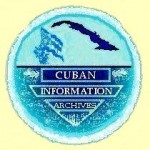
TheCubanHistory/ Arnoldo Varona, Editor



 U.S. Treasury 1961 Cuba Report
U.S. Treasury 1961 Cuba Report
